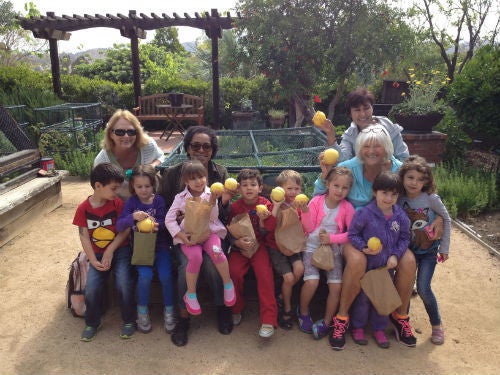
Kids and elders grow fruits and vegetables together at a preschool in San Diego County.
In a recent Generations United/The Eisner Foundation nationwide survey conducted online by Harris Poll*, more than half of the respondents said that few of the people they regularly spend time with are much older or much younger than themselves.
It wasn’t always this way. We once lived in multi-generational homes, in multi-generational communities. That was the norm.
But as Americans began to recognize both children and elders as vulnerable populations that deserved public protection, schooling became compulsory, child labor was banned, and, thanks to Social Security and Medicare, retirement became a standard phase of life. And because of these changes, children and elders thrived as never before. But the changes also consigned both groups to isolation—not only from mainstream society, but from one another.
Americans still believe that kids and older adults merit special treatment. Our survey shows that over 90% think that children, youth and elders are vulnerable populations that society must protect. But that protection should not equal isolation—and Americans believe that too.
Over 90% of survey respondents said that older and younger generations mutually benefit from building relationships across generations. In fact, most adults in our survey—78 percent—are so convinced that the young and the old are good for one another that they want the federal government to play a role in fostering ties between them. And 77 percent of adults wish there were more opportunities in their own community for people from different age groups to meet and get to know one another.
If integrating younger and older community members became not only a priority but a policy, it would be better for all of us. For one thing, when the generations don’t mix, it’s easy for them to see one another as rivals for scarce societal resources. By contrast, when people of all ages get to know one another, they tend instead to unite around shared goals. Additionally, fostering intergenerational connections can have significant implications for healthcare, infrastructure and education in the U.S.
Health Care
Nearly half of elders report feeling lonely at least occasionally, while 19 percent report frequent loneliness—and loneliness is linked to depression, cognitive decline, high blood pressure, and premature death.
Through organizations like DOROT, this year’s recipient of the Eisner Prize for Intergenerational Excellence, isolated elders enjoy regular contact with energetic young people through meal delivery programs, visitation programs, homelessness prevention initiatives, teen internships and more. Older adults engaged in intergenerational programs like those at DOROT feel more optimistic and take better care of themselves. Coupled with a decrease in the health effects of loneliness, this decreases their need for medical attention and eases the burden on the healthcare system.
Infrastructure
When kids and elders are served at a single facility rather than at two separate ones, costs per client decline—saving taxpayers money. For example, at the St. Ann Center for Intergenerational Care in Milwaukee, preschoolers and older adults are served under the same roof. But the efficiency of a single location is just one of the benefits of this center—children and seniors interact throughout the day, creating connections and building friendships that they wouldn’t have otherwise.
Intergenerational programs can also facilitate community improvements. A group from the Northland Foundation’s “AGE to age” initiative in Minnesota revitalized a blighted park in a small rural community. After thousands of volunteer hours from youth and seniors alike, “Generations Park,” as it has been renamed, is the crown jewel of the community, with a butterfly garden, a pavilion, picnic tables, and a farmer’s market. Creating infrastructure that benefits all generations means these investments go further.
Education
Beginning with the Foster Grandparents Program over 50 years ago, elders have long volunteered in schools. While we still need to make it easier and more common, others are now creating innovative avenues to connect generations in education settings.
Take Ithaca College for example. A short walk or shuttle ride from the college, Longview retirement community buzzes with students. Musicians and dancers stage performances for residents; history and journalism majors benefit from their life stories. Gerontology students experience aging, while budding physical, occupational, and speech therapists help assess and treat their ailments. Meanwhile, Longview residents swim in the college’s pool, use its library, attend plays and other campus performances, and audit any courses they like.
Dismantling age segregation won’t be easy; true social change never is. But success stories like these show us the potential of increased intergenerational connections in our society. When combined, the wisdom of our elders and the energy of our young can make our communities stronger.
* Survey Methodology: The Generations United/Eisner Foundation survey was conducted online by Harris Poll February 15-17, 2017 among 2,171 U.S. adults ages 18 and older. This online survey is not based on a probability sample and therefore no estimate of theoretical sampling error can be calculated. For complete survey methodology, including weighting variables, please contact Generations United at gu@gu.org.